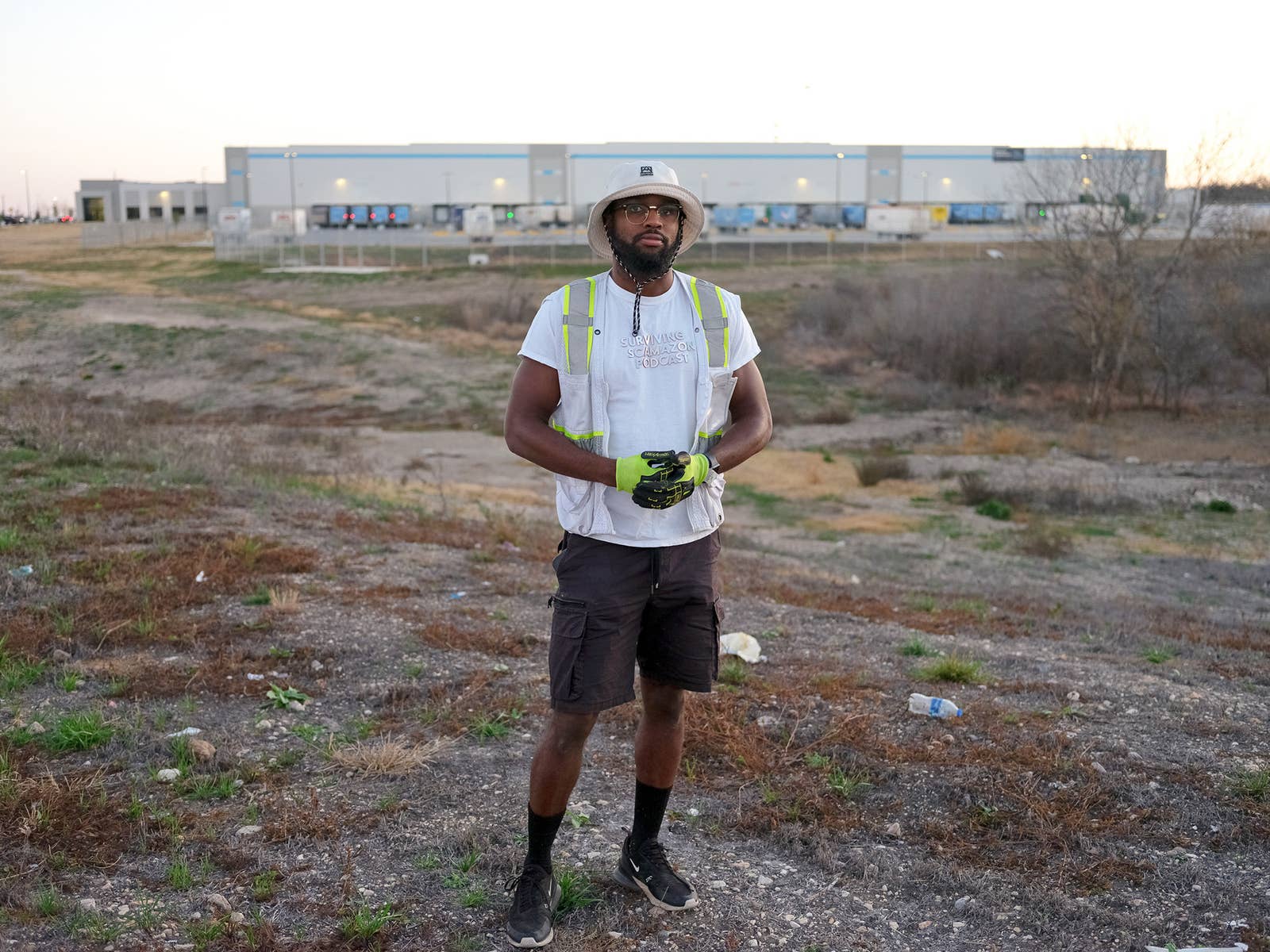
In May 2022, Daniel Olayiwola, a 29-year-old picker at an Amazon warehouse in San Antonio, spoke at the company’s shareholder meeting. As an employee, he held a small number of vested stock options that he was able to buy, making him an official shareholder, but a warehouse worker had never introduced a proposal at the annual gathering before, which is typically dominated by the major investors focused on Amazon’s plans to raise profits and dividends.
Near the end of the virtual meeting, Amazon’s moderator played the two-minute recording Olayiwola had sent in advance. In the statement, Olayiwola said he was proposing a resolution to end the company’s “injury crisis” by getting rid of the productivity quotas and surveillance mechanisms that push workers to prioritize speed over safety out of fear of losing their jobs.
“I’ve personally felt the physical toll of working for Amazon,” he said in the recording. “I’ve seen my coworkers work themselves to exhaustion.”
The resolution he submitted included citations of news investigations, research studies, and a government inspection report collectively showing that injury rates at Amazon warehouses were higher than at non-Amazon warehouses thanks to conditions that sometimes violated labor laws.
In the overview it sent to shareholders before the meeting, Amazon argued against calls for policy change by noting that its “worker incident rate” had declined since 2019. “Safety is integral to everything we do at Amazon, as demonstrated by our relentless focus on health and safety training, engagement with employees, and refinement of our processes to improve working conditions,” the company stated. “Our commitment to supporting our employees’ well-being and success is demonstrated through our competitive compensation and employee benefits.”
In a statement responding to questions for this story, Amazon spokesperson Sam Stephenson defended the company’s productivity expectations, which he said are “based on time and tenure, peer performance, and adherence to safe work practices,” and its use of surveillance, which he said is “common practice at nearly every major retailer in the world” and helps “ensure employee safety, inventory quality, or protect against theft.”
When Olayiwola’s recording ended, a heavy silence fell over the line. Then the moderator noted that Amazon recommended that shareholders vote against the resolution. And most did, sinking the proposal.
Olayiwola wasn’t sure if he had just cost himself his job.
“I was super scared about speaking out for the longest, but I was thinking, like, Dude, they’ve already fired everyone you know. Just consider yourself fired,” he said. “I kept on thinking, They could fire you anytime, and if they do, nothing you say will matter. Say what you say right now while you’re in here, so they can’t say I’m just speaking out because I got fired.”
Amazon spokesperson Stephenson said that Olayiwola’s job wasn’t at risk because “retaliation of any kind isn’t tolerated.”
But Olayiwola wasn’t sure what to expect when he showed up at the warehouse the next week. On the way to his work station, he said, a manager stopped him. To his surprise, the manager told Olayiwola he respected him for speaking up. But, he added, a job in an Amazon warehouse was still better than most alternatives. “You could have it a lot worse,” Olayiwola recalled the manager saying.
He wasn’t fired. But none of his proposals were put into place.
So last summer, he started a podcast with the provocative title Surviving Scamazon, posting the short episodes on YouTube, so far seven in all, two- to 10-minute monologues each focusing on different slices of company policy and how they affect workers. The videos haven’t gotten more than a few hundred views and are far from the polished productions of full-time creators, but they stand as a noteworthy case of a non-unionized, low-wage worker creating an independent channel to publicly and non-anonymously call out the company actively employing them. Olayiwola hopes his initiative spurs others to contribute their voices, perhaps one day forming a vast digital chorus clamoring for corporate accountability.
“The sooner we open a dialogue, the sooner we can start to figure out what’s going on and see what we can try to change or fix,” he said in the first episode, which went up in July.
The podcast is only part of his effort to amplify his message. Over the last year, he has done interviews with at least four news outlets, published an op-ed in Fortune, and volunteered as a leader for United for Respect, an advocacy group that campaigns on behalf of retail workers.
“Everybody was so scared about speaking out,” he said. “I felt like I had to do something to inspire others to tell their experiences working at Amazon.”
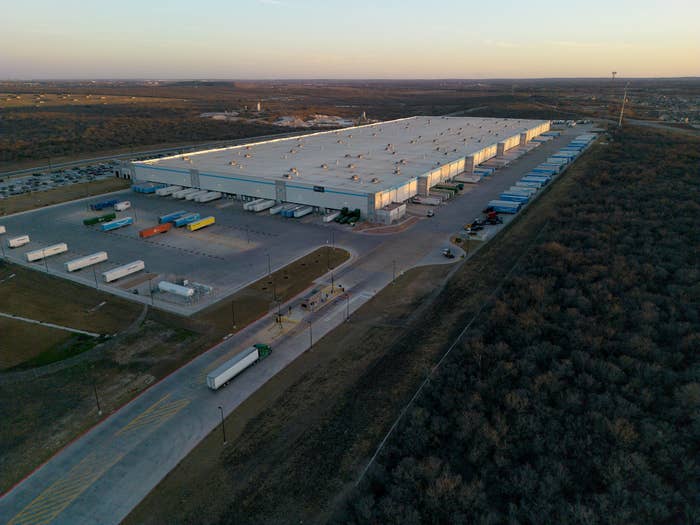
A military veteran with a newborn child at home and five years of productive work at Amazon on his resume, Olayiwola casts a sympathetic image. He has wondered if he remains employed because the company realizes that firing him would risk drawing even more attention to the issues he keeps speaking up about.
“I’m thinking I might stay at Amazon for a while,” Olayiwola said. “Like everybody else, I’m just trying to find stability. I’m not anti-Amazon, I don’t hate Amazon, I’m just tired of the way they treat people.”
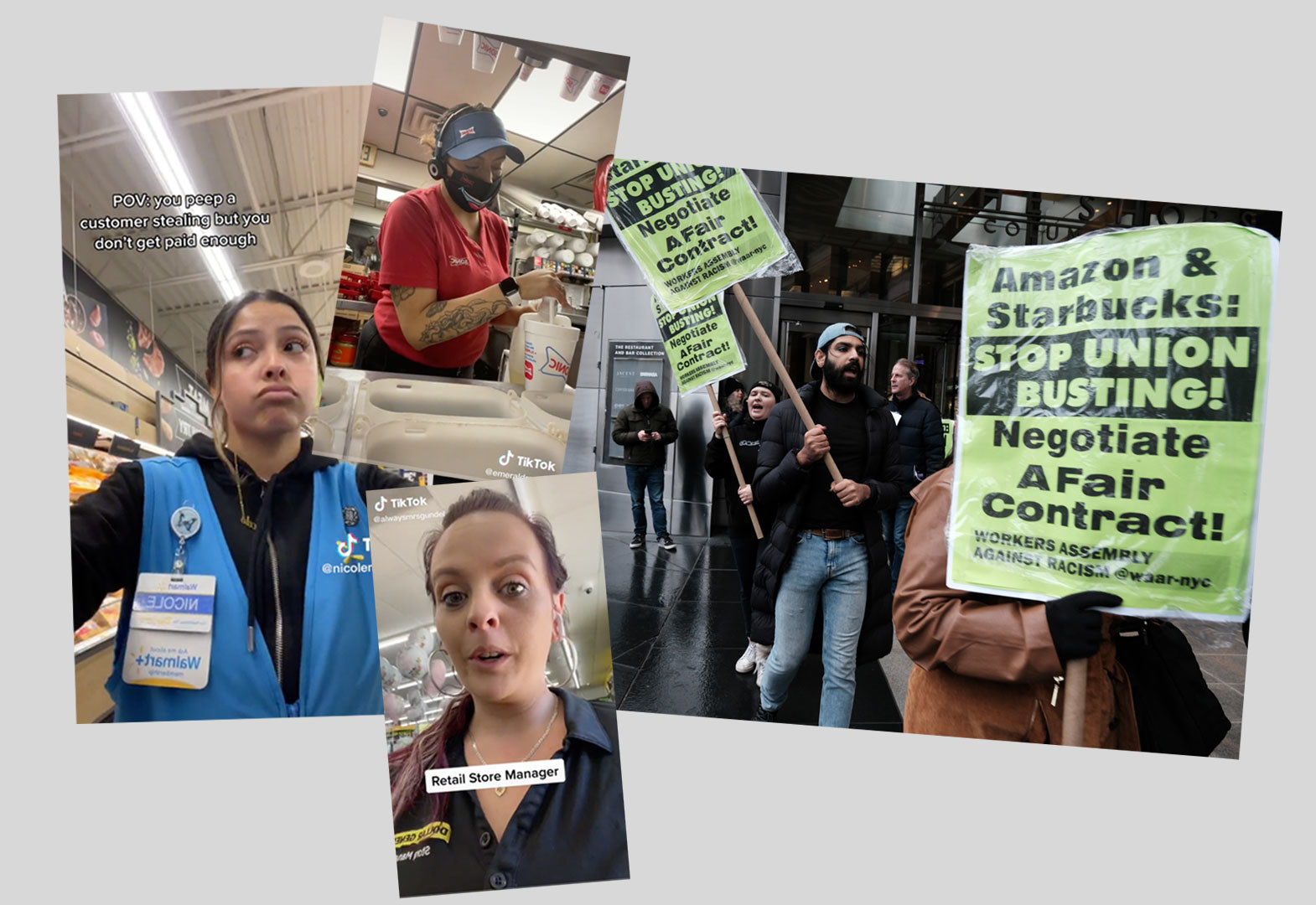
Olayiwola is part of a growing swath of low-wage workers publicly calling out their corporate employers for labor conditions that they say leave them overworked and underpaid.
While an Amazon warehouse in New York became the first to unionize in company history last year, no others have successfully followed suit. And while more than 270 Starbucks branches have unionized over the past year, overall union membership at companies around the country dropped to its lowest rate in 2022 since the Bureau of Labor Statistics started keeping track in 1983.
In the absence of union protections and campaigns, workers have turned to more informal methods for building pressure on companies to raise wages. Retail workers at Dollar General, Walmart, Sonic, and Burger King, among others, have filmed TikTok videos chronicling what they say are routine challenges on the job. Last year, low-wage service workers across the South formed an unofficial union through the labor rights group Raise Up the South. In recent months, fast-food workers across California have rallied outside the state capitol calling for legislators to support AB 257, which proposed stricter oversight of labor conditions and opened the door for wage raises but is now on pause after the restaurant industry filed a lawsuit to put the law up for a public vote next year.
While corporate employers have the authority to fire workers without cause and labor protections are notoriously difficult to enforce, a shortage of prospective job applicants has empowered many low-wage employees with newfound leverage. These days, “We’re Hiring” signs hang on countless retail windows across the country, and many workplaces have operated shorthanded since the pandemic’s early months. This shifting dynamic traces back to a dark reality: Recent research has revealed that the national worker shortage was in part due to so many service workers dying from COVID-19 or declining to return to work after catching it.
Employers considering whether to discipline vocal workers may also weigh the consequences they risk for terminating those who speak out. After management at a Staten Island Amazon warehouse fired Chris Smalls, a worker leading protests for safer working conditions in 2020, the incident fueled the first successful union drive in company history. Smalls became the face of the campaign, a modern-day labor icon marching across Amazon parking lots in his signature red hoodie and sideways snap-back. His trajectory showed how an act of corporate aggression can turn a little-known advocate into a martyr recognized from coast to coast.
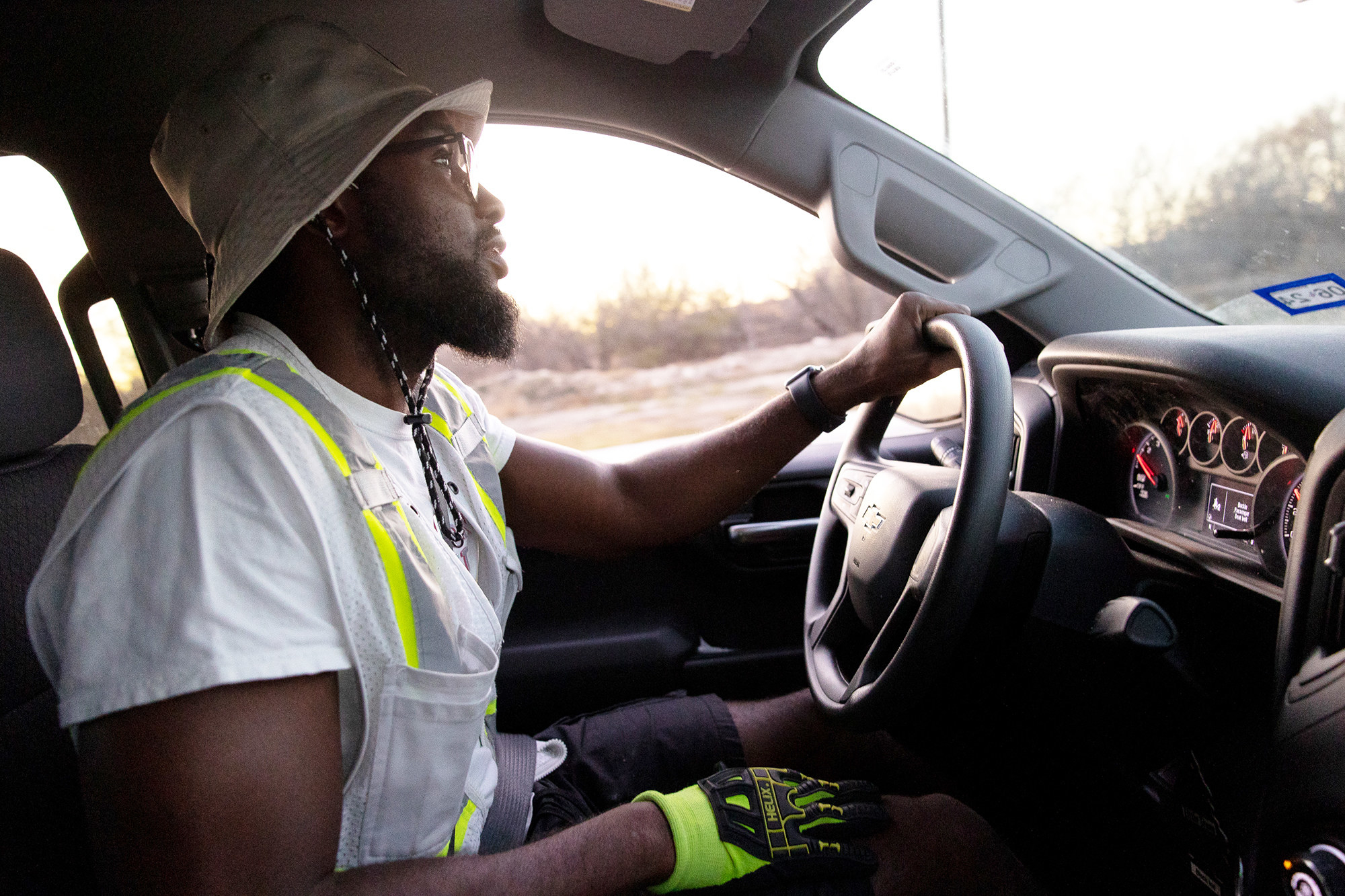
The son of a Nigerian immigrant nurse and a car salesperson with deep roots in the South, Olayiwola joined the military right after graduating high school in Jacksonville, Florida, because he “didn’t have a way to pay for college,” he said. He served five years as a combat medic in the Army reserves, then got a job as an EMT at a homeless shelter, then as a delivery driver for UPS. When he saw an online ad about openings at Amazon, the job benefits appealed to him: a 401(k) plan, shares in the company, opportunities for raises, and the freedom to transfer to facilities anywhere he wanted to move to.
If anything, Olayiwola embodies the sort of career Amazon proudly promotes. He started at a warehouse in Jacksonville, making $11 an hour. In the years since, he has worked at seven Amazon distribution centers across Florida and then Texas as he moved homes. He got certified to handle a forklift and settled into a role as a picker, pulling bins from shelves and moving items to a conveyor belt as quickly as he could to meet productivity expectations that determined his fate at the company. The job took a toll on his mental health, he said.
“You be getting home and thinking about not meeting rates and not [sleeping] very well at night,” he said. “It’s kinda traumatizing.”
He made good rates. He was young and in strong physical condition. Many of his colleagues were in their 50s and 60s. Few of them lasted long before losing their jobs.
Within two years, he said, he found he was often one of the most experienced employees in warehouses that cycled through workers quickly, shedding excess labor during slow seasons and staffing back up during peaks. Often, he’d see old colleagues return when the next hiring surge came around, starting again at the entry-level salary floor.
“They built these warehouses in places where people need work and run them through the gauntlet, but they still go back,” he said.
Amazon maintains that the turnover only affects workers who sign up for short-term contracts.
“During our peak season, we provide seasonal employment options for people looking for temporary roles and flexibility,” Amazon spokesperson Stephenson. “Headcount reductions following peak season impact employees who were hired with the understanding that their roles were seasonal.”
“You be getting home and thinking about not meeting rates and not [sleeping] very well at night,” he said. “It’s kinda traumatizing.”
By 2019, Olayiwola had maxed out his raises, which at the time capped out at around $18 an hour. He grew increasingly frustrated that his income wasn’t keeping up with his rising living costs, even as each shift left his body sore and his mind drained.
That October, he started posting videos about his experiences on the job. His first, a four-minute vlog aiming to “document the internal struggle that I get from Amazon,” contains confessional-type clips of him walking into the warehouse before work or sitting in his car after work, venting about “how bad it is in there” and being “so tired my knees hurt all the time.”
“I just ran out the sweatshop,” he says to the camera. “I’m really happy not to have to work tomorrow.”
His second video, in November, stitched together glimpses of workers crowding around break room microwaves with clips of him calling for a raise to $20 an hour and a 45-minute break. Neither video garnered more than a few hundred views, but Olayiwola found the outlet cathartic.
“Someone has to say something because most people do not care,” he says now of his decision to start publicizing his opinions on the internet. “Part of it is getting the information out that this is wrong and they need to stop doing this to people.”
After those first two videos, though, he worried about getting fired if he kept going and decided it wasn’t worth the risk. He’d only been at the company for two years and “wanted to have a solid tenure” moving forward, he said. So he stopped posting his thoughts.
But he started hearing from other Amazon workers after they saw his videos on Facebook, who told him about United for Respect, which has campaigned on behalf of Amazon workers for years and organized a community of employees advocating for policy changes. Olayiwola stayed in touch with the group, keeping tabs on the rallies, walkouts, and other labor actions simmering at facilities around the world.
He was working at an Amazon warehouse in Dallas when the pandemic started and was present when Jeff Bezos visited the facility for a walk-through of safety conditions. Two months later, one of his coworkers there, Daniel Warren, died from COVID-19. Olayiwola learned about the death when he arrived at work one day and saw Warren’s face on a big TV in the break room as a memorial.
As the pandemic continued across the globe, Amazon workers protested unsafe working conditions and low pay, escalating a labor rights movement that had started years before. In France in April, a judge ordered Amazon to suspend its operations in the country until it improved its safety protocols in warehouses — the company agreed to new policies approved by the union before beginning to reopen facilities in mid-May. In Poland from March through the end of the year, workers went on a series of strikes to call for higher wages, though the actions have yet to lead to any changes. In Bessemer, Alabama, workers organized a union campaign that came close to winning but fell just short in March 2021. In Staten Island, New York, in the year leading up to a March 2022 union election, Smalls rallied his former coworkers to join the Amazon Labor Union, which he’d just founded.
Through those months, though, Olayiwola’s mind was on more personal matters. When his wife was pregnant with their first child, they moved to San Antonio to be closer to her family. In summer 2021, their daughter was born. With their budget stretched tighter, he said, he started pulling money from his 401(k) savings. Even with his wife’s income from her job in the insurance industry, Olayiwola said he realized he needed a second job to cover all their bills, which now included $280 in daycare every week. He started picking up work as a roofer.
Two or three days a week, he said, he wakes at 5 a.m., arrives at a roofing job around 6:30, and puts in six to eight hours before heading to the Amazon warehouse for his night shift, which runs from 6:30 p.m. to 1:30 a.m. He clocks 60 hours a week between the two jobs, enough for all the bills to get paid every month but not enough to escape paycheck-to-paycheck precarity, he said.
He found himself stuck “in a situation where you have no upward mobility, no ability to save up money, in a cycle of literally poverty, even though this is one of the top companies in the world,” he said.
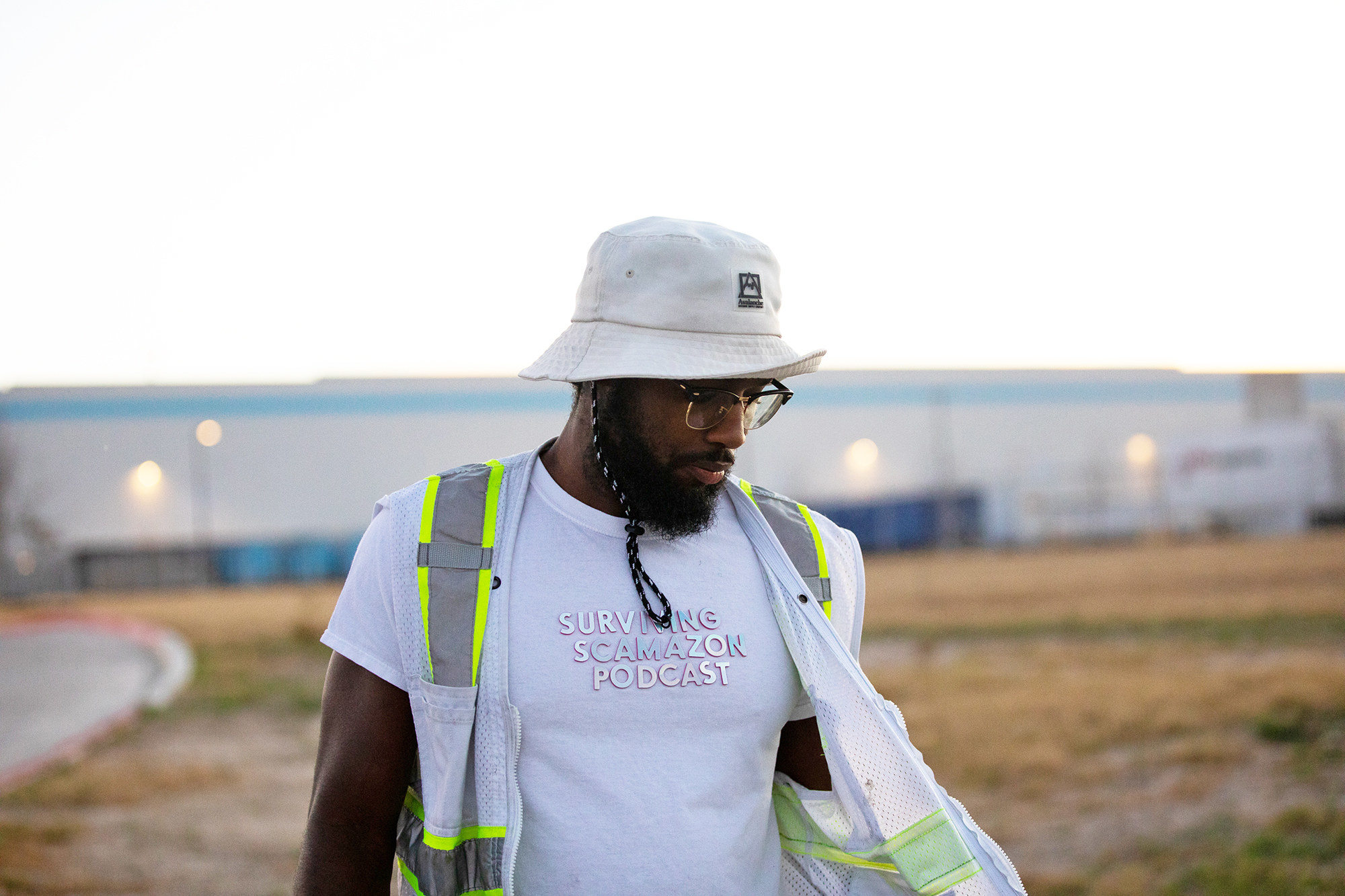
Reflecting on it, he noticed that his complaints echoed those he repeatedly heard from coworkers. He thought about the coworkers who iced their knees in their cars after shifts, the coworkers who returned to lower-paid positions after getting fired because there wasn’t any better option on the job market, and the coworkers who expressed resignation at the conditions, convinced that nothing would ever change. Having worked at Amazon for five years and witnessing conditions at seven facilities, Olayiwola came to the realization that he was probably one of the most qualified employees to speak with authority about the physical and financial struggles warehouse workers experience. In early 2022, he decided that he was willing to risk getting fired for the chance to nudge the company toward even incremental changes.
Through United for Respect, he attended an online class on organizing, which laid out his legal rights and made him feel more comfortable “to become more involved,” he said.
His approach wasn’t radical — it was pragmatic. Though some Amazon workers in other warehouses tried to unionize, Olayiwola sought more modest aims, hoping to reason with management rather than battle them. “They’re really anti-union, so let’s try other ways,” he said. “I just wanted to get a dialogue started.”
The shareholder meeting offered him a chance to get his message across to people with real influence in the company — and to open a line of communication on their terms. Working with United for Respect organizers, he put together a proposal focusing on ending the policies he found most detrimental to workers: the quotas that pushed them to exhaustion and the surveillance that pressured them to maximize their effort at all times. Once he’d purchased some of his vested stock options, he emailed the corporate office requesting a chance to introduce the proposal at the upcoming gathering. To his surprise, they approved his request.
“We encourage you to provide us with a pre-recorded audio file in advance of the meeting that we will play to present your proposal,” Senior Corporate Counsel Jung Ju said in the email. “I look forward to hearing from you.”
Listening to his own voice on the call, Olayiwola imagined what was going through the heads of the wealthy investors on the line. Who let this broke warehouse worker in here to speak his mind? he suspected some of them were thinking. We don’t care what’s going on in the warehouse.
But then it was over. The shareholders followed the company’s recommendation to vote against the proposal. Olayiwola went down in history as the first Amazon warehouse worker to pitch a policy proposal at a shareholder meeting, but his moment in the spotlight was merely a perfunctory bump in the road for a company pursuing ever-higher revenues.
Nonetheless, the experience emboldened him. Two months after the May shareholder meeting, he posted the debut episode of his Surviving Scamazon podcast on YouTube. He has posted at least one episode a month since then. Unlike his videos from 2019, which centered the toll the job was taking on him, these carry the tone of a grizzled veteran passing down hard-won lessons about navigating Amazon warehouse work.
He aims for the episodes to resemble the conversations he and his coworkers have in break rooms. He issues warnings about managers discouraging vacation during the high-demand holiday season, demonstrates stretches he likes to do at his workstation, reads out complaints posted on an internal employee forum, and chronicles the walkouts and strikes at facilities around the country.
“I wanted to give us a platform to talk about what we really want and need,” he said.
Olayiwola is far from a social media influencer. He doesn’t have much time to create content. He’s still learning how to edit videos. None of his posts have gone viral. He is still figuring out the format for his show. He hopes to feature fellow Amazon employees as guests one day, but first he hopes to inspire them to feel comfortable enough to speak publicly about their experiences.
He said that managers tell him they’ve seen his posts, but he hasn’t faced any reprimands, warnings, or punishment. Sometimes a manager will even tell him, “Thanks for the callout. We’ll get right on that,” he said. But he said he hasn’t seen much change. He supports efforts to unionize at Amazon, but the high turnover rates have made it hard for organizers at warehouses around the country to build momentum. The conditions he stepped into when he first took the job remain in place.
Thinking back on the past couple of years, he could recall just one policy shift that he deemed “a little bit” of progress. For years, Olayiwola had taken issue with the price of food in the warehouse cafeteria, from the vending machine snacks to the $15 lunches. (Amazon spokesperson Stephenson said its vending prices are “20% below market value.”)
Then, several months ago, Olayiwola said he arrived at work to find a rare mark of good news: There were now free bananas. ●
